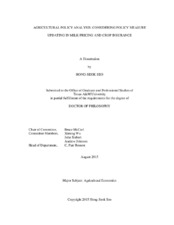| dc.contributor.advisor | McCarl, Bruce | |
| dc.creator | Seo, Hongseok | |
| dc.date.accessioned | 2015-10-29T19:39:54Z | |
| dc.date.available | 2017-08-01T05:37:26Z | |
| dc.date.created | 2015-08 | |
| dc.date.issued | 2015-06-11 | |
| dc.date.submitted | August 2015 | |
| dc.identifier.uri | https://hdl.handle.net/1969.1/155423 | |
| dc.description.abstract | This dissertation investigates the possibility of updating policy features to reflect more current data within the realm of policies related to milk pricing and crop insurance. Two policy settings are examined. First, the possibility of adjusting Federal Milk Marketing Order price differentials to reflect fuel price increases, spatial supply-demand shifts and seasonality is analyzed using a spatial dairy sector transport and processing optimization model. Second, the effect of including technical progress effects in crop yields is examined within the content of yield guarantees under the crop insurance policy.
This dissertation is composed of three essays. The first two address the milk price differentials study. The first essay presents details on the model that was constructed to examine the milk pricing issue. The model is a spatial transport and processing model that develops a spatial pattern of milk prices. The second essay uses the model from the first essay to investigate U.S. milk pricing. It examines how price differentials are affected by changes in fuel costs, locations of supplies and demand and seasonality. The results show incorporating fuel cost and location shifts raises the magnitude of the differentials by about 115%. We also find that consideration of seasonality affects the differentials. Collectively the results indicate that it may be desirable to revisit the policy determined price differentials.
The third essay examines the effects of crop insurance alterations on farmer’s yields risk. In particular, the effects of the pilot Trend Adjusted-Actual Production History program are examined econometrically. The results show the TA-APH program is effective in mitigating risk and that it increases insured acres by 3% for corn and 5% for soybeans. It also shows that the farmers eligible for the program would sign up for a lower coverage level relative to ineligible farmers. However, the overall level of coverage increases. Collectively the evidence shows the TA-APH program is effective in mitigating yields’ risk. | en |
| dc.format.mimetype | application/pdf | |
| dc.language.iso | en | |
| dc.subject | agricultural policy | en |
| dc.subject | classified pricing | en |
| dc.subject | Class I milk price differentials | en |
| dc.subject | crop insurance | en |
| dc.subject | trend adjusted | en |
| dc.subject | actual production history yields | en |
| dc.title | Agricultural Policy Analysis: Considering Policy Measure updating in Milk Pricing and Crop Insurance | en |
| dc.type | Thesis | en |
| thesis.degree.department | Agricultural Economics | en |
| thesis.degree.discipline | Agricultural Economics | en |
| thesis.degree.grantor | Texas A & M University | en |
| thesis.degree.name | Doctor of Philosophy | en |
| thesis.degree.level | Doctoral | en |
| dc.contributor.committeeMember | Siebert, John | |
| dc.contributor.committeeMember | Wu, Ximing | |
| dc.contributor.committeeMember | Johnson, Andrew | |
| dc.type.material | text | en |
| dc.date.updated | 2015-10-29T19:39:54Z | |
| local.embargo.terms | 2017-08-01 | |
| local.etdauthor.orcid | 0000-0002-3025-2079 | |


